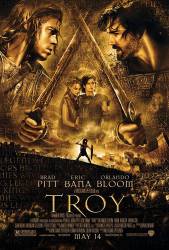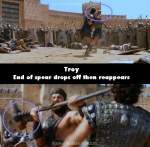Trivia: Due to the political situation in Iraq, the location for scale shots was moved from Morocco to Mexico, an ideal alternate choice with its broad beach. However, the rushed decision presented some obstacles. Coastal Mexico is an endangered turtle habitat, so to be granted permission to set up the Greek encampment and build boats on the large stretch of beach, the film crew implemented their own turtle incubation nursery, releasing a multitude of turtles while on location in Mexico. They also did not have an accurate idea of the physical conditions of that particular beach - it was unstable and 100 feet of beach washed away overnight, leaving Greek ships teetering precariously on the edge of the bank with the missing sand.
Trivia: The huge bald Boagrius at the beginning of the film who gets killed by Achilles is truly indeed a big person. Although slightly modified by digital technology, he is in real life 6'10", 330 pounds. He is professional wrestler Nathan Jones.
Trivia: Near the end of the movie, Paris hands the Sword of Troy off to a young man called Aeneas saying something along the lines of "Troy will always have a future so long as this sword is held by a Trojan." This was a little nod to Virgil's Aeneid which describes the travels of Aeneas after the Trojan War and who was an antecedent of Romulus and Remus (the legendary founders of Rome).
Trivia: Brad Pitt, portraying Achilles, actually injured his Achilles tendon in September 2003, while filming, which delayed the shooting of the climactic battle scene with Eric Bana, until December. The Achilles tendon is named after the mythological Greek warrior Achilles, who according to legend was mortally wounded by an arrow that hit his Achilles tendon. Achilles became almost entirely invincible to injury when his mother immersed him in the magical Styx River. Since she held him by the heel, which was not immersed in the river, Achilles had only one weak spot, his Achilles tendon, which ultimately led to his downfall.
Trivia: According to legend, Achilles' only vulnerable spot was his heel, where he eventually was hit with a poisoned arrow. The movie shows how such a legend can arise - when the soldiers first come to Achilles' body, he has pulled out all of the arrows in his chest and the only one visible is the one in his heel.
Trivia: Two of the warriors on opposite sides of this war were on the same side of another. Brendan Gleason played Menelaus, husband of Helen and James Cosmo played Glaucus, Priam's military advisor. They played Hamish Campbell and his father in the film "Braveheart" (1995).
Trivia: Keep an ear out - the 1st Wilhelm is heard when the second (not the first!) Myrmidon screams as he falls overboard into water, after being hit by Trojan arrows. The 2nd Wilhelm is heard moments later, when Achilles and his Myrmidons are in their shield formation, one Myrmidon stands behind the formation and fires an arrow into a Trojan, who screams as he falls.
Trivia: According to the commentary on Disc 2, most of Troy's wall and gate set was destroyed by Hurricane Marty in September 2003, just before filming was set to begin for the Achilles vs Hector fight scene. The crew decided to rebuild the whole thing and coincidentally this is about the same time that Brad injured himself.
Trivia: The director was very careful about showing the relationship between Achilles and Patroclus. In Ancient Greece, venerable warriors were given young boys to train in the arts of war and "love." Historians say that this is probably what was the real relationship between the two. Homosexual relationships between older men and usually teenage boys were tolerated and sometimes glorified in ancient Greece.







Answer: He doesn't yell any words, just an expression of anguish over his brothers death.